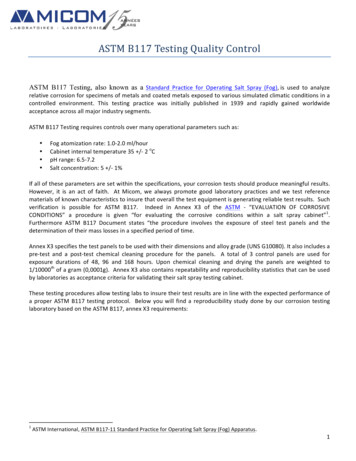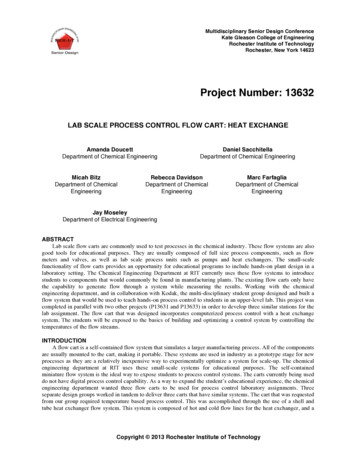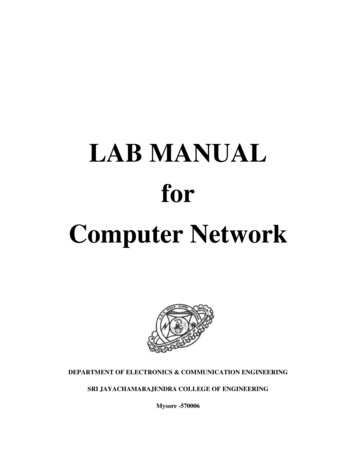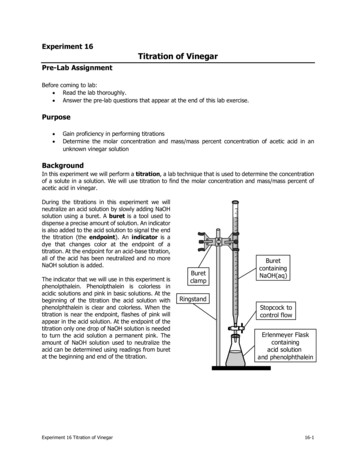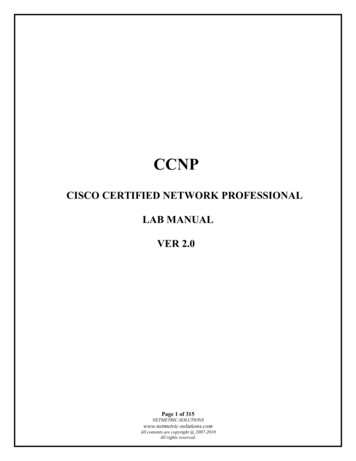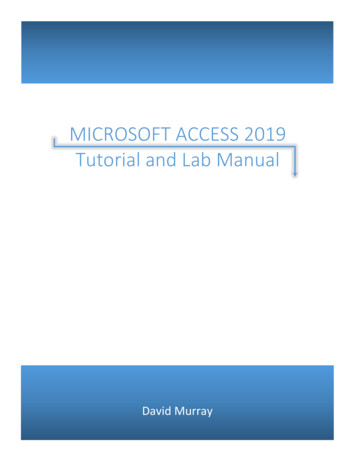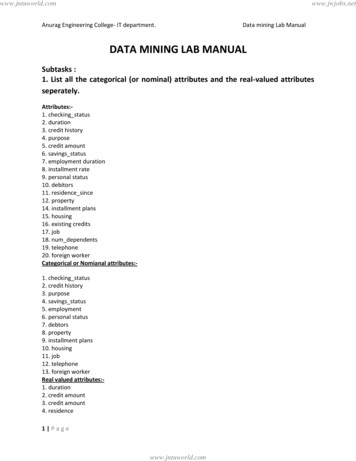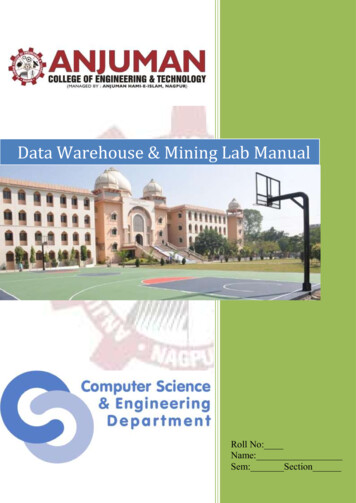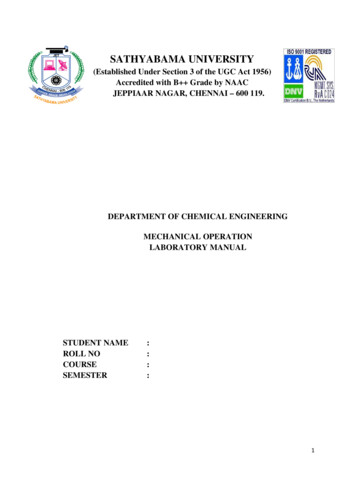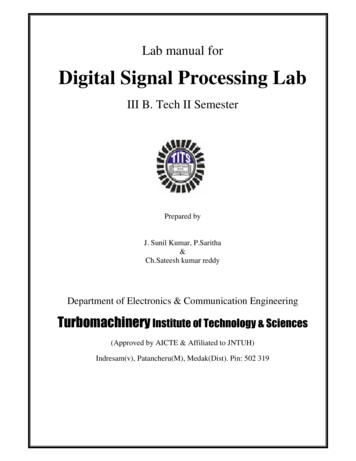
Transcription
Lab Manual for EE380 (Control Lab)Department of Electrical Engineering, IIT KanpurManavaalan Gunasekaran and Ramprasad PotluriLab Manual Version: September 10, 2013New in this version: Experiments 1, 2, 3 shortened;Experiment 9 added.
September 10, 2013EE380 (Control Lab) IITKiiLab Manual
ContentsPreface0.1 Skills the control experiments need to impart0.2 Past status of Control Systems Laboratory . .0.2.1 Logistical challenges . . . . . . . . . .0.2.2 Solution to these challenges . . . . . .0.3 Planning for the future . . . . . . . . . . . . .0.3.1 Models for the experiments . . . . . .0.3.2 Suggested new set of experiments . .Contributions to the lab12viiviiviiiviiiviiiviiiviiiixxiThe experimental setup1.1 Introduction . . . . . . . . . . . . . . . . . . . . . . . . . . . . . .1.2 Microcontroller dsPIC30F4012 . . . . . . . . . . . . . . . . . . . .1.2.1 Timer Module . . . . . . . . . . . . . . . . . . . . . . . . .1.2.2 Pulse Width Modulation (PWM) Module . . . . . . . . .1.2.3 Quadrature Encoder Interface (QEI) Module . . . . . . .1.2.4 Universal Asynchronous Receiver Transmitter (UART)Module . . . . . . . . . . . . . . . . . . . . . . . . . . . . .1.2.5 GPIO Pins . . . . . . . . . . . . . . . . . . . . . . . . . . .1.2.6 Analog to Digital Convertor (ADC) . . . . . . . . . . . .1.3 Choice of sampling interval . . . . . . . . . . . . . . . . . . . . .1.4 Parameters of PMDC motor-gear-encoder unit . . . . . . . . . .1.5 Characteristics of the H-bridge board . . . . . . . . . . . . . . . .1.6 Calculation of B and armature resistance . . . . . . . . . . . . .1.7 Programming . . . . . . . . . . . . . . . . . . . . . . . . . . . . .1.7.1 Writing from PC to dsPIC . . . . . . . . . . . . . . . . . .1.7.2 Reading the data from dsPIC to PC . . . . . . . . . . . .1.8 Program listings . . . . . . . . . . . . . . . . . . . . . . . . . . . .1.8.1 main-prog.c . . . . . . . . . . . . . . . . . . . . . . . . . .1.8.2 settings-prog.h . . . . . . . . . . . . . . . . . . . . . . . .1.8.3 readplot.m . . . . . . . . . . . . . . . . . . . . . . . . . . .1.9 Schematic of the dsPIC30F4012 board . . . . . . . . . . . . . . .344466788999131618Experiment 1: PMDC motor modeling, identification, speed control2.1 Goals . . . . . . . . . . . . . . . . . . . . . . . . . . . . . . . . . .2.2 Exercises . . . . . . . . . . . . . . . . . . . . . . . . . . . . . . . .2.2.1 To do at home . . . . . . . . . . . . . . . . . . . . . . . . .19191919iii111222
September 10, 2013.20212222232424242525Experiment 2: Speed of PMDC motor tracks reference sinusoid3.1 Goals . . . . . . . . . . . . . . . . . . . . . . . . . . . . . . . .3.2 Questions . . . . . . . . . . . . . . . . . . . . . . . . . . . . .3.2.1 To do at home . . . . . . . . . . . . . . . . . . . . . . .3.2.2 To do in lab . . . . . . . . . . . . . . . . . . . . . . . .3.3 Dead zone in the Vm versus u characteristic . . . . . . . . . .3.4 System identification . . . . . . . . . . . . . . . . . . . . . . .3.5 Program listings . . . . . . . . . . . . . . . . . . . . . . . . . .3.5.1 sysid.m . . . . . . . . . . . . . . . . . . . . . . . . . . .3.5.2 simsine.m . . . . . . . . . . . . . . . . . . . . . . . . .3.5.3 readSID.m . . . . . . . . . . . . . . . . . . . . . . . . .27272727293131323234362.62.7456Lab Manual.2.32.42.53EE380 (Control Lab) IITK2.2.2 To do in lab . . . . . . . . . . . . . . . . . . . . .Physics-based model of the DC motor unit . . . . . . .System identification . . . . . . . . . . . . . . . . . . . .Discretized version of the controller . . . . . . . . . . .2.5.1 Conversion from transfer function to state-space2.5.2 Discretization of the state-space equation . . . .2.5.3 Time-domain recursion . . . . . . . . . . . . . .Simulation . . . . . . . . . . . . . . . . . . . . . . . . . .Program listings . . . . . . . . . . . . . . . . . . . . . . .2.7.1 easysim.m . . . . . . . . . . . . . . . . . . . . . .Experiment 3: Ziegler-Nichols tuning of speed controller of PMDCmotor4.1 Goals . . . . . . . . . . . . . . . . . . . . . . . . . . . . . . . . . .4.2 What is controller tuning? . . . . . . . . . . . . . . . . . . . . . .4.3 What the two ZNT methods do . . . . . . . . . . . . . . . . . . .4.4 First method . . . . . . . . . . . . . . . . . . . . . . . . . . . . . .4.5 Second method . . . . . . . . . . . . . . . . . . . . . . . . . . . .4.6 A modification of the plant . . . . . . . . . . . . . . . . . . . . .4.7 Questions . . . . . . . . . . . . . . . . . . . . . . . . . . . . . . .4.7.1 To do at home . . . . . . . . . . . . . . . . . . . . . . . . .4.7.2 To do in lab: Second ZNT method . . . . . . . . . . . . .39393940404142434344Experiment 4: Control of speed using armature current5.1 Goals . . . . . . . . . . . . . . . . . . . . . . . . . . .5.2 Application of this problem . . . . . . . . . . . . . .5.3 Background . . . . . . . . . . . . . . . . . . . . . . .5.4 Questions . . . . . . . . . . . . . . . . . . . . . . . .5.4.1 To do at home . . . . . . . . . . . . . . . . . .5.4.2 To do in lab . . . . . . . . . . . . . . . . . . .5.5 Explanation for the C code related to currents . . . .5.5.1 Reading the current through ADC . . . . . .5.6 Systematic method to determine i versus isens . . . .5.7 Post-experiment discussion from 2011 . . . . . . . .4545454646464850505052Experiment 5: Control of armature current6.1 Goals . . . . . . . . . . . . . . . . . . . . . . . . . . . . . . . . . .6.2 Application of the problem . . . . . . . . . . . . . . . . . . . . .535353iv.
September 10, 20136.36.46.56.6789EE380 (Control Lab) IITKWell-regulated current . . . . . . . .To do at home . . . . . . . . . . . . .To do in lab . . . . . . . . . . . . . . .What to check if things do not work.Lab Manual.53545858Experiment 6: Disturbance observer7.1 Goal . . . . . . . . . . . . . . . . . . . . . . . . . . . . . . . .7.2 Background . . . . . . . . . . . . . . . . . . . . . . . . . . .7.2.1 Application of DOB . . . . . . . . . . . . . . . . . .7.2.2 Model of pmdc motor with well-regulated current .7.2.3 DOB for a pmdc motor with well-regulated current7.3 Questions . . . . . . . . . . . . . . . . . . . . . . . . . . . .7.3.1 To do at home . . . . . . . . . . . . . . . . . . . . . .7.3.2 To do in lab . . . . . . . . . . . . . . . . . . . . . . .7.4 Programs provided . . . . . . . . . . . . . . . . . . . . . . .59595959596060606163Experiment 7: Disturbance observer without feedback of current8.1 Goal . . . . . . . . . . . . . . . . . . . . . . . . . . . . . . . . . .8.2 Background . . . . . . . . . . . . . . . . . . . . . . . . . . . . .8.3 Questions . . . . . . . . . . . . . . . . . . . . . . . . . . . . . .8.3.1 To do at home . . . . . . . . . . . . . . . . . . . . . . . .8.3.2 To do in lab . . . . . . . . . . . . . . . . . . . . . . . . .8.4 M-files . . . . . . . . . . . . . . . . . . . . . . . . . . . . . . . .65656566666668Experiment 8: PMDC motor modeling, identification, position control9.19.29.39.49.5Goals . . . . . . . . . . . . . . . . . . . . . .Introduction . . . . . . . . . . . . . . . . . .Mathematical model of DC servo motor . .Dead zone in the Vm versus u characteristicQuestions . . . . . . . . . . . . . . . . . . .9.5.1 To do at home . . . . . . . . . . . . .9.5.2 To do in lab . . . . . . . . . . . . . .717171717272727310 Experiment 9: Encoderless speed control of PMDC motor using compensation of plant nonlinearity10.1 Questions . . . . . . . . . . . . . . . . . . . . . . . . . . . . . . .10.1.1 To do at home . . . . . . . . . . . . . . . . . . . . . . . . .10.1.2 To do in lab . . . . . . . . . . . . . . . . . . . . . . . . . .75757576Software used79v
September 10, 2013EE380 (Control Lab) IITKviLab Manual
PrefaceHere we describe our considerations in designing the control systems laboratory component of EE 380 (course title “Electrical Engineering Laboratory”)around an apparently simple DC motor control testbed.0.1Skills the control experiments need to impartEE380 is a four credit hour laboratory course. Control systems constitutes onethird of this course. Given that we currently have only one control systemscourse active at the UG level at IITK, and that the one-third of EE380 is theonly exposure the students have to a control systems laboratory at IITK, whatdo we want the students to learn from this brief exposure to the controls lab?Here is one answer: In addition to helping the students practice paper-basedor PC-based design techniques, most of which they may have seen in theirlecture course on control systems, we believe that controls experiments needto help the students acquire the following skills associated with converting thepaper-based or PC-based design into a practical system:1. Ability to identify the hardware and software that are needed in a basiccontrol system.2. Ability to make this hardware and software work together.3. Ability to debug small errors that may appear during practical implementation.This knowledge comes only through at least a few weeks of work on problems,all of which may be related to one or two hardware setups that are not — anddo not look — complex.Overall, the lab experiments need to give the student confidence enough to say,“I have practical experience with implementing control systems in addition todesigning and simulating them”.vii
September 10, 20130.2EE380 (Control Lab) IITKLab ManualPast status of Control Systems LaboratoryUp to the August – December semester of 2008 EE380 had 4 sections of up to24 students. Each section was divided into 6 groups of up to 4 students.0.2.1Logistical challenges1. Six different experiments were done concurrently during each lab sessionwith support from two TAs per session. Therefore, each TA and tutorneeded to know all the 6 experiments every week, thus putting pressureon them.Thus, in any given week, the TAs expended more effort than if they were allpreparing for the same experiment.2. Also, with increased student intake (with up to 30 students per section),under that model, we would have had cacophony in the lab with everyonespeaking about a different experiment.3. With increased student intake, multiplying the then existing set of experiments would have been expensive. It would have been expensive to increase the number of inverted pendulums, or the number of ball and beamsetups, or even the number of DAQ cards from NI. An inverted pendulumor a ball-beam setup comes for about Rupees Five Lakh each.0.2.2Solution to these challengesThe solution is for all the students, TAs, and tutors to do the same experiment ina given week. This model exists in the ESO210 labs, for example. It has thefollowing advantages:1. We will need only 2 – 3 TAs per section.2. The students, TAs, and tutors will generate more knowledge than if theywere all working on different experiments.3. It will be easier for the entire class as everybody is talking about the samething in a given week.0.3Planning for the future0.3.1Models for the experimentsWe may have two models for the control experiments:Model 1 The student sees one experimental setup in each experiment (e.g.,magnetic levitation, dc motor control, ball and beam, inverted pendulum,etc.). The student designs a controller for the given system based on a mathematical model that was provided by the control system’s manufacturer,viii
September 10, 2013EE380 (Control Lab) IITKLab Manualand inputs the values of the controller’s parameters into a convenient interface provided on the control system. The control system itself has beenbuilt by someone else and is almost a black box to the student.Pro: This way, the student becomes acquainted with the various control experimental setups that are available in the market, and the real-life systemeach of these setups models. But, the student could have learned this fromwww.youtube.com too.Pro: The students may learn that a control system works differently in practice than on paper.Pro: This kind of an experiment impresses upon the student the wide applicability of control systems theory.Con: The student does not see the hardware innards of the control system,nor does he/she talk to anybody that has actually built this setup and couldshare his/her experience building it.Model 2 The student works with only one or two experimental setups throughthe semester.Pro: The student solves many different problems associated with each setup.This way, the student can learn how a practical control system is actuallybuilt after the paper-/PC- based design and simulation.The pros in Model 1 are not significant enough for the student to spend asemester in the EE380 labs. On the other hand, the pro of Model 2 is. Werecommend Model 2 as it is in consonance with Sections 0.1 and 0.2.2.0.3.2Suggested new set of experimentsWe recommend a phased introduction of Model 2 described in the previoussubsection. Towards this end, we suggest that in the first two years of introduction of this new plan, the students will perform single-loop experimentsthat only involve the control of a DC motor, and design and simulation usingMATLAB/Octave/Scilab.The DC motor control experimental setup offers rich possibilities for learningthe practical aspects of control systems design and implementation. Quanserhas a DC motor control kit with a user manual that lists at least 6–7 experiments1 . We could borrow ideas from that list too apart from using the experiments that we have already designed.In the July — December semester of 2009, we introduced 4 new experimentsinvolving control of DC motor. Thus, we already have experience with thesenew experiments.For additional details, please see the paper [1].1
MATLAB/Octave/Scilab. The DC motor control experimental setup offers rich possibilities for learning the practical aspects of control systems design and implementation. Quanser has a DC motor control kit with a user manual that lists at least 6–7 experi-ments1. We could borrow ideas from that list too apart from using the experi- ments that we have already designed. In the July — December .

